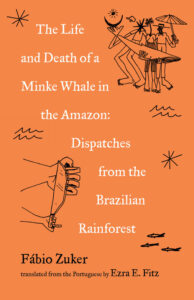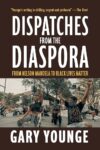
[Milkweed Editions; 2022]
Tr. from the Portuguese by Ezra Fitz
Not a fish — the whale is in between zones that are more often assumed as fixed, land and sea. What this interstitial status signifies to those humans variously eaten by (Jonah), obsessed with (Ahab), or, more recently, worried about (marine biologists) whales, has been the fodder for cultural and literary discussions for millennia. What this in-between-ness means for the whale, is a story as much about revelation, that such a being in-between exists at all, as about revelation’s limits, that such a being might never be fully comprehended by those of us strictly beholden to land or sea.
The meaning of a whale on a beach was at the center of one episode in the Brazilian Tapajós River in late 2007. One of the larger tributaries to the Amazon River, the Tapajós cuts through the northern, inland Brazilian state of Pará, and is rather a ways from the Atlantic depths that a variety of whales routinely traverse for hunting and migration. The events of a Minke Whale’s sudden appearance on the banks of the Tapajós, in a bramble just south of Santarém, a city at the convergence of rivers, form the titular story of Fábio Zuker’s essay collection The Life and Death of a Minke Whale in the Amazon and Other stories of the Brazilian Rainforest, translated from the Portuguese by the veteran Ezra Fitz, and a debut book for Zuker, whose short-form journalism has appeared in a variety of outlets across Europe and the Americas.
For Zuker, stories of the Minke Whale prompted him, more than a decade later, to conduct field research in Pará, for his dissertation in Social Anthropology. For ecologists and cetacean scholars, the Minke Whale’s stranding — and subsequent floundering, escape back through the labyrinthine tributaries of the region, recapture by rescue services, escape again, and, days later, final surrender to the riparian shallows — meant there was something terribly wrong in the ocean, whether too many boats bumping into baleens, or shifting sea levels otherwise disrupting the echolocation that guides orcas, dolphins, and whales around shoals and through familiar hunting waves. For Jair Bolsonaro, the dramatic event meant reason to send reporters into Native Space, reporters who doubled as land surveyors keen on evaluating the logistics of seeding soy bean plantations for global trade in animal feed, in the steads of Indigenous settlements, the thickest jungle, and the biodiverse canopies of the Amazon. For the myriad Amerindian peoples from along the Tapajós, the whale meant — the whale. That is, one of nature’s most astonishing entities, and as such, a sacred entity whose appearance promises rejuvenation and persistence for those willing to behold and offer their respects. Indeed, Zuker concludes “The Life and Death” essay by describing how it was no question among Santarém’s local peoples that they would gather all together and “carry the whale, in their arms, to the large lake in the heart of Piquiatuba,” where fish abound and the whale could eat, swim, live richly, and be visited by locals as it had visited them. For the whale, we all might never know.
This tale joins a dozen others that take up the Amazon as an ecological, historical, and social space, and together make up Zuker’s keen collection: reportage ranging from ever surging numbers over the last decades, of Venezuelan migrants through the northwest Brazilian state Roraima, to ever increasing nationalist efforts to remove Indigenous peoples from their lands, and industrialize the vast arable of the Amazon, to the withstanding coronavirus pandemic and its seizure of the Borari Native, Dona Lusia don Santos Lobato, before infections disproportionately pummelled Indigenous peoples across the region. More than a series of discrete entries, however, it is navigating and negotiating how any representation of one story entails representing, and interpreting others, that drives Zuker’s discussions. How do haphazard refugee camps in border towns and overpasses witness Venezuelan migrants and Warao Natives at violent odds about displacement and replacement? How are claims to land at once an ancestral practice, a mode of dispossession, and newly empowering? How does empowerment through agriculture unfold when farmers, whether Indigenous, migrant, or Brazilian criollo, succumb to the billowing smoke of deforestation projects to clear their lands, are invaded by too liberally sprayed pesticides that promise higher crop yields, and are in constant danger of attack by megafires spurred by these very agricultural endeavors? How can so many peoples come together over a whale, and yet see their visions of such an event keep them in mortal combat?
The Life and Death chronicles this traffic, often with an earnest perspective and in a prose that gets close to clarifying the dizzying array of motives and consequences for movements in and out of the forest, Zuker’s included. Zuker seamlessly weaves quotations from all of these actors throughout, yielding a readable polyphony that conveys these interlocking scenes, consistently forwarding voices summarily silenced, and reframing voices that have had too much air. He is sensitive to parsing and recording nuances in identity that otherwise go violently ignored by the larger continent’s nation-states, writing at one point, “in the Amazon, the line separating those who are Indigenous from those who aren’t always seems to be more fluid and more complicated than the government can handle.” He is adamant about a different practice.
The anthropological eye and journalistic approach of The Life and Death render Zuker’s registering and accounting for these nuances variously successful. When describing his disorientation in the rainforest while traversing the Tupinambá lands with Indigenous guides, Zuker’s self-deprecation on the one hand signals Indigenous expertise that is beyond his own, but on the other hand, displaces any robust reflection on the alternative modes of travel practiced by the Tupinambá peoples. Focusing on his foibles in navigation, these scenes skirt thinking about how Zuker’s limited abilities here signal not strictly his own naivety, but rather, the constitutive exclusion of Indigenous forms of knowing and being that Western practices have been designed to operate against. Though Zuker does not frame it as such, this is a scene not about his inability to learn to read the clouds like the Tupinambá peoples, but about the history of colonization bent on rendering Indigenous cartographies as illegible and non-existent. Later, when recounting the efforts by João Paulo Luma Barreto to facilitate “communication and cooperation between the complex system of Indigenous beliefs and the canon of western medicine” through the Bahserikowi’i Medicine Center in Pari-Cachoeira, a border zone between Brazil and Columbia, Zuker recounts the story of Luciene Lima Barreto who was bitten by the venomous jararaca snake, and the subsequent modes of care she variously pursued and to which she was subjected. As a case-in-point of the important work of the Bahserikowi’i Medicine Center, the story of Luciene Lima Barreto is also one that the woman herself “refused to talk about.” Zuker explains, “she did, however, agree to let her father” recount the events, before himself reproducing them in the following pages. Considering the long history of especially the role Anthropology has played in extracting Indigenous stories and materials for public showcasing, in other parts of the world far away, however, it is unfortunate to see Zuker speed past this woman’s objection to share her history. What would this history look like if Luciene Lima Barreto’s refusal was kept central to it?
Striving to clarify and reveal the intersections and convergences of experiences and their meanings in the Amazon, Zuker can as much overexpose this way, as haphazardly withhold. This withholding can revealingly challenge readers to dwell in uncertainty and confusion, a prompt for recognizing alternative approaches to expression and community that require patience to learn. At other times, this withholding can be unfortunately misleading. Zuker is quiet about dates, making it hard to tell when exactly an event he describes took place. An interesting consequence occurs in the titular tale, when time seems to proceed not along any linear or standardized path, but according to the Minke Whale’s appearance, disappearance, reappearance, and when peoples first heard about the situation or later history. Location is also a regular mystery. This is especially problematic for stories from Piquiatuba and Pari-Cachoeira, spaces not expressly recognized by the state of Brazil and absent from mainstream maps and databases, but that nevertheless decidedly persist. Zuker never explains as much. On the one hand, should one go to search maps and databases and the news for mention of these sites, this move by Zuker re-stages the disorientation he describes earlier, and prompts readers to dwell in an uncertainty that reorients questions about geography, expertise, and history. On the other hand, this ambiguity risks downplaying the practice of what Chippewa writer Gerald Vizenor has named survivance, or the collective being-against as much as outside-of governments and ideological frameworks bent on eliding Indigenous histories, presence, and futures.
Zuker ends his collection with a discursive exposition of his approach, a method of writing “nearby,” which entails a practice of being close but not intrusive of those peoples and their histories of subjugation as much as refusal across the Amazon. Describing how he came about this approach, however, Zuker recounts the ways in which he felt that his earlier work in art history inadequately compared with the political work his peers were variously engaged in, thus his turn to the Minke Whale and the traffic in the rainforest, through plantations, across medical units, and into migrant camps.
An overly critical reading of this conclusion would announce the seeming self-investment of this project. A rightly generous reading, however, would avow The Life and Death an important illustration of how hard it can be to keep personal motivations, expectations, and convictions out of the way of de-colonial and anti-colonial historiographical work. Zuker is not Indigenous, but he never explicitly addresses the Western traditions that would position him as white and that ultimately protect him in these complicated contexts, even as he clearly desires to topple the traditions that are making these contexts complicated. Instead, Zuker emphasizes more logistical limitations, whether in interpreting, traveling, and being, before Indigenous expertise, the singular migrant experience, and the devastating inexplicableness of a Minke Whale’s seeming suicide-mission, and in this way, only ever gestures towards social, historical, and cultural dynamics that remain opaque to him. His frankness in these moments is nevertheless a refreshing renunciation of the mastery expected of social scientists, and that is broadly foundational to such Western epistemologies. And the form, a collection of essays, enacts the gathering of multiple times, spaces, languages, and peoples that this renunciation in turn gestures towards. Zuker’s failures are precisely his successes, then — his diligent grappling, all the while, proves a model for thinking about the complicated but crucial politics of care in an uneven world.
Katrina Dzyak is a PhD Candidate in English and Comparative Literature at Columbia University.
This post may contain affiliate links.







